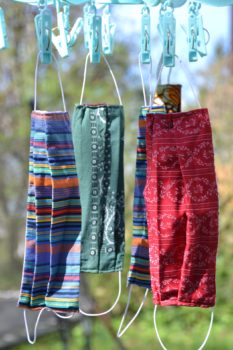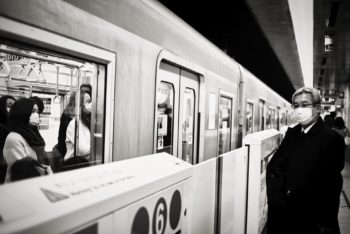Where are Anime Masks? Posted by eriko1 on Nov 18, 2020 in Culture
It’s 2020, so we need to talk about masks(マスクmasuku) – masks that prevent(防ぐfusegu) COVID-19 from spreading, masks that divided (分割する bunkatusuru) the United States, and masks that are new fashion items.
Before we were shifted to work at the home mode in early March, I had a group of Japanese college students visiting from Japan in February. Their travel agent in Japan had a pre-departure orientation and talked about the masks not being culturally(文化的にbunkatekini) familiar in the US. Of course(もちろんmochiron), he could not tell them not to wear it. But he was well aware of an incident in NY, where a mask-wearing Asian had been attacked.
They arrived in the US, and the airport concierge escorted them out of the arriving area of the airport. They were maskless.
I can only talk about Japan, but wearing a mask has been a way of life in the flu and allergy seasons in Japan for a long time. The main reason is not to pass germs to other people as well as not catching them. It is due to the social pressure(社会的圧力shakaiteki atsuryoku) that the Japanese are surrounded by 24/7 – the fear of what people would say if you are doing something different from a group.
With the rise of the COVID-19 cases, the American scene has drastically(大幅にouhabani) changed. Many people started wearing a mask. As disposable masks had never been a staple in the US market, people were wearing a mask made of clothes.
Meanwhile, in Japan, the shortage of disposable mask was as bad as the toilet paper shortage. So they started to wear masks made of clothes. YouTube was full of videos on how to sew a mask and how to make a mask without sewing.
But I found one huge difference between the Americans and Japanese wearing the clothes masks.
While Americans have started to wear hand-sewn masks that were very colorful or showed something that they like such as a breed of dogs or a band, the Japanese continued to wear black or white masks. It was not that masks with designs were unavailable. Even swimsuits makers and lingerie makers shifted their production lines to make colorful and beautiful masks. But you do not see Japanese wearing them. Then I saw one of my Japanese friends’ Facebook posts. He showed a mask that he had got from some special place or event. But he did say that he would not wear it to work.
So that is it. No need to be self-assertive(自己主張するjiko shuchousuru) or no need to stand out(目立つmedatsu).
Taro Kono is a member of the House of Representatives(衆議院議員shuugiin giin) in Japan. He has been very popular among young people or Japanese who have lived/educated overseas because of his rather maverick(独自路線のdokujirosenno) character even though he belongs to the conservative(保守的なhoshutekina) Liberal Democratic Party (自民党Jimintou). He has been wearing colorful masks in press conferences – a soccer team of his region, his hometown, etc.
Back in May, he came out in his camo mask when he was the Secretary of Defense(防衛大臣bouei daijin). A member of the press asked if it was OK to wear masks other than (〜以外のigaino) white ones. He answered that it was perfectly fine when people took a mask as a fashion item.
Now you see many politicians wearing masks that promote (宣伝するsendensuru) their regions.
However, the Japanese business community is more conservative as evidenced in this photo below. But there are many colorful masks available. Where are they??
There was no discussion of individual rights(個人の権利kojin no kenri) and wearing a mask in Japan. The Japanese government cannot enforce people to wear a mask or lockdown the country. They can only recommend(推奨するsuishousuru). Because of civil rights(公民権kouminken)abuse(乱用ranyou) during World War II, Japan has very strict laws protecting civil rights. So the government relies on social pressure.
So many dreams and plans have been destroyed by the pandemic. But we have learned to appreciate what we had for granted.
Happy Thanksgiving(感謝祭kanshasai)!

Build vocabulary, practice pronunciation, and more with Transparent Language Online. Available anytime, anywhere, on any device.






Comments:
Lynn:
Thank you, that was very interesting and told a lot about the Japanese culture. I wish we felt the same pressure to keep ourselves and others safe!
eriko1:
@Lynn Thank you, Lynn!! Without government imposed lockdown, I believe Japan has managed the COVID-19 fairly well (although they are in crisis with 2000+ infection/day for the first time.) However, there were lines of people at Pachinko game center (a kind of gambling) during the stay-at-home recommendation time. Some pachinko operators in the industry was not cooperative, and some people who waited for the pachinko centers to open might have gambling addiction problems. But there was nothing anyone could do because Japan has no laws such pandemic. The government was to discuss to come up with stronger laws to respond to this kind of pandemic. Social pressure works in Japan, but it also is very difficult to live wth. Thank you for reading and thank you for your comment!